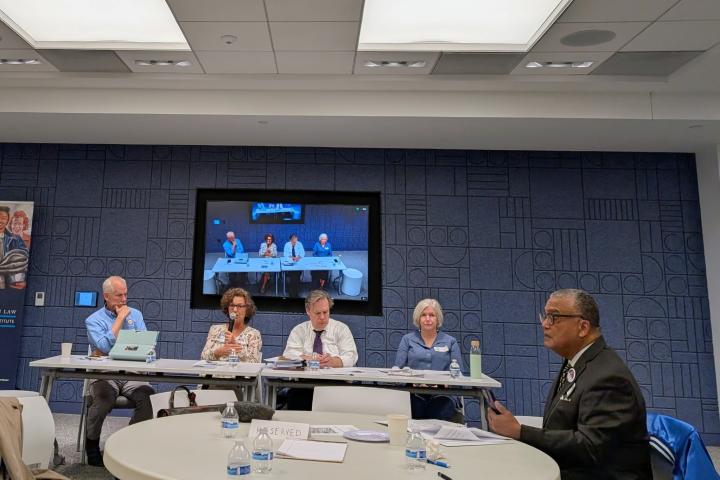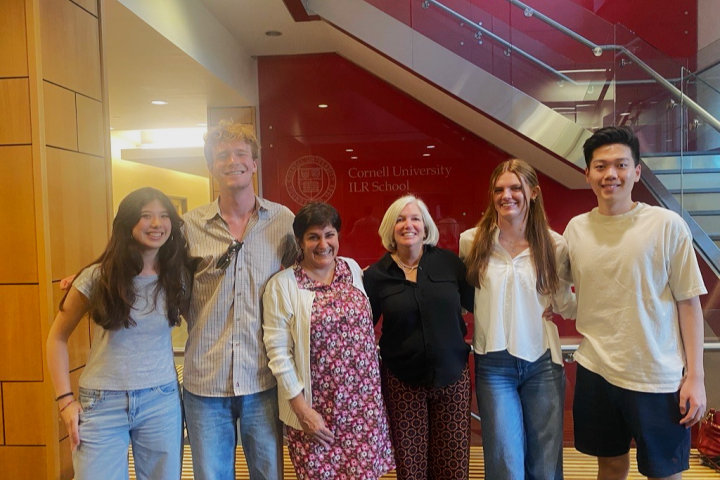New Report finds New Yorkers want increased investment in child care
Child care is the workforce behind New York State’s workforce. The release of “The Status of Child Care Across New York State;” marks the third phase in an action research project on the true cost of child care, coordinated by Cornell University’s ILR Buffalo Co-Lab between 2021 and 2024. As a result of findings from phase I and Phase II of the Child Care studies, lawmakers implemented many reforms reflected in NYS budgets for 2022-2023 and 2023-2024 that aligned with ILR Buffalo Co-Lab recommendations. While the initial influx of NYS funding helped to stabilize the child care industry during and immediately after the pandemic, the availability of child care has not improved, and has even worsened, in many parts of New York State.
Cathy Creighton, Director, ILR Buffalo Co-Lab, Rusty Weaver, PhD, director of research, PhD and Steve Peraza, PhD, senior researcher and policy associate, led the roll out of the report’s findings on March 8 in Buffalo, NY. Vonetta T. Rhodes, Director of the WNY Child Care Action Team coordinated parent and day care provider representatives, sharing evidence of what the data suggests--that child care professionals earn the fourth lowest in wages and salaries among all New York State professions.
Rosalyn Cheatom, Director of Our Family Child Care shared, “it is said that child care is essential for parents to earn thriving wages. As a provider, it is my duty to provide quality child care—but I am also a parent. And as a parent I struggle to provide for my own family. My question is, Where is my duty and responsibility to my family to provide my own family with thriving wages? Help me make that make sense.”
According to the Department of Labor’s report, “Child Care in New York State, 2023,” child care workers in the Child Day Care Services Industry earn a median wage of just $32,900. When compared to the median wage of all New York workers, $54,300, those who work in child care earn about 39 percent less on a yearly basis. Twelve percent of child care workers in New York State fall below the poverty line. “Low wages not only hinder the attraction and retention of competent, qualified staff but also disrupt continuity of care and the routines upon which children thrive,” said Kristina Kleeh, MA/CAS, Executive Director of Just for Kids, who operates 17 licensed School Age child care programs for six local school districts, serving approximately 1200 students and employing over 180 staff.
Sofia Mado, Director of the Harlem Children’s Center, had to close 3 of her 4 child care centers, over the last three years because of rising costs and an inability to find child care workers, “at the heart of it, it is our children who bear the brunt of this crisis – deprived of the uplifting, appropriate, and quality-driven care they deserve.”
Parent representative, DeShaun Baldwin, recounted her search for quality child care, “my child wasn’t even been born yet, and I was several daycare waiting lists,”—a story all too familiar to many families across the state, who are struggling to find spots for their children among the many child care deserts and then struggle to afford the high costs.
“If the moral case isn’t good enough, we can also make more economic arguments. According to our survey data from Cornell University’s 2023 Empire State Poll, two out of five New Yorkers with children report that they or an adult member of their household decided to forgo employment outside of their home largely due to the high cost and availability of child care; when parents are unable to work due to child care issues, labor shortages are exacerbated. Seventy-eight percent of New Yorkers agreed that child care workers should be paid on par with elementary school teachers and 79% of New Yorkers said they support public funding for universal child care,” said one of the report’s authors, Dr. Rusty Weaver.
Sheri Scavone, CEO Western NY Women’s Foundation, and long time child care advocate reminded attendees that it was appropriate to recognize this policy priority on International Women’s Day. With over 69,000 child care workers across the state, 94% are women and 58% are women of color; therefore their low wages and poor benefits exacerbate existing patterns of economic and racial inequality. Scavone also notes that investing in child care makes economic sense. The data demonstrates that an investment of $1 billion would generate $1.8712 billion in economic activity – a nearly two-to-one return on the initial investment. Scavone said, “New York needs a bold, equitable and inclusive Universal Child Care system that recognizes child care as an essential right for the education of young developing minds and, an essential workforce support - especially for women. There is no better return on investment for the State finances and for all of humanity.”
Legislators agreed on the urgency of pursuing more than band-aid solutions to this pressing issue. Assemblymember Wallace, who advocated for the initial study of the child care landscape in 2021, shared alongside her WNY Delegation colleagues, “Despite historic increases in childcare funding, the results are clear: we must do more to increase access and make childcare affordable to working families across New York State. We’ve seen more and more parents leave the workforce because childcare is just too expensive. That hurts businesses and it hurts families. Providing affordable childcare is a win-win for everyone in New York State."
Senator Brisport, Chair of the New York State Senate Committee on Children And Families, who was also in attendance, said, “These findings from Cornell make it painfully clear: the small patchwork of child care investments New York has made over the past few years absolutely pale in comparison to the scale of the crisis. Piecemeal, temporary grants have not meaningfully addressed the issue and will never be able to resolve it. Every day we wait to invest in Universal Child Care — with child care workers paid as the vital educators they are — we cause more harm to New York’s child care workers, families, and entire economy.” Advocates and providers praised Senator Brisport and Assemblymember Hevesi’s leadership on child care issues.
The study utilized a two-pronged approach methodological approach:
- quantitative analyses of economic and demographic data gathered from a wide range of sources, featuring survey data from Cornell University’s 2023 Empire State Poll as well as data visualizations which map the economic status of child care providers and workers in various regions of NYS.
- With generous support from the Community Foundation of Western New York, researchers conducted qualitative focus groups with 40 members of the Erie County child care community, including child care providers, advocates, and county and state officials.
The report calls for state investment in a New York State Child Care Compensation recommending a state-provider partnership to ensure that child care workers receive pay commensurate with other early childhood educators in the state.
Cornell ILR Buffalo Co-Lab partnered with numerous stakeholders including Live Well Erie, Erie County Child Care Taskforce, NYS Assembly Member Monica Wallace, NYS Assembly Member Karen McMahon, Senator Brisport, The Western NY Child Care Action Team, The Western New York Women’s Foundation, Workforce Solutions Consortium, Child Care Resource Network, Partnership for the Public Good, The John R. Oishei Foundation, child care providers, and advocates to determine the true cost of child care.
Access the full report here: https://hdl.handle.net/1813/114331
View the March 8 report roll out event here: https://www.youtube.com/live/6XR1Gwq6SPE?si=Do7lTaCWCvUfXPTQ



